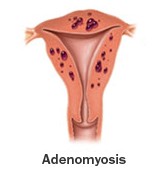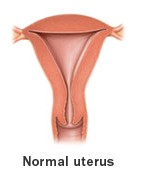 Adenomyoma growths in the wall of the uterus. |
AdenomyosisContents • What Is Adenomyosis? |

Related Articles |
What Is Adenomyosis?
Adenomyosis is where endometrial tissue - the tissue that normally lines the womb - grows inside the wall of the womb (uterus). It most often occurs later in a woman's childbearing years after having children. It is not the same as endometriosis - a condition where parts of endometrial tissue escape the womb and implant on organs outside it (like the fallopian tubes or ovaries). However, many women with endometriosis also have adenomyosis. While the cause of adenomyosis is unknown, it typically disappears after menopause. For women who experience severe symptoms, certain treatments can help but ultimately the only cure (if it does not resolve itself) is hysterectomy (removal of the womb). In many (probably undiagnosed) cases, it produces no symptoms, or only mild discomfort. In others, it can result in:
Scientists have still to identify the cause of adenomyosis. It is more likely to occur in women over 30 who have had children, and in those with previous uterine surgery, including cesarean section. Possible theories include: Your doctor may notice that your uterus is enlarged during a routine pelvic examination. An ultrasound of the womb will help to differentiate between adenomyoma and other uterine tumors such as uterine fibroids, uterine polyps and endometriosis. An MRI scan will be ordered if the ultrasound does not give clear results. An endometrial biopsy can help rule out other conditions, but it cannot diagnose adenomyosis. The only way to be 100 percent certain of adenomyosis is to examine a sample of uterine tissue under a microscope after hysterectomy.
As adenomyosis usually disappears after menopause, treatment may depend on how close the woman is to that stage in her life. Treatment options include: Anti-inflammatory medications: Taking anti-inflammatory medications like Ibuprofen (Motrin IB or Advil for example) can help relieve pain. By starting your meds 2 or 3 days before your period, and continuing to take it during your period you can lighten blood flow and reduce pain. Does Adenomyosis Cause Infertility? Increasingly more women suffering from infertility are being diagnosed with adenomyosis in fertility clinics across the United States. This does not necessarily mean that adenomyosis causes infertility - it may just that the detection rate is increasing as women delay having children until their 30s and 40s when the incidence rate of adenomyosis is naturally higher. In theory, because an adenomyoma is a structural gynecological disorder, it would be fair to assume it could have some impact on fertility. The evidence is not yet available to make this judgment call. Can It Cause Pregnancy Complications? In theory, adenomyosis may increase the risk of pregnancy complications by compromising the function of the uterus. Possible complications include premature labor, placenta abruption, miscarriage and need for cesarean section. However, because the condition is not often diagnosed prenatally, there is not enough evidence to draw definite conclusions.
|
| Related Articles on Endometrial Problems
For more endometrial issues, see the following: • Endometriosis symptoms: Endometrial implants. Back To Homepage: Womens Health Advice |
|
WOMENS HEALTH ADVICE: ABOUT GYNECOLOGICAL DISORDERS |